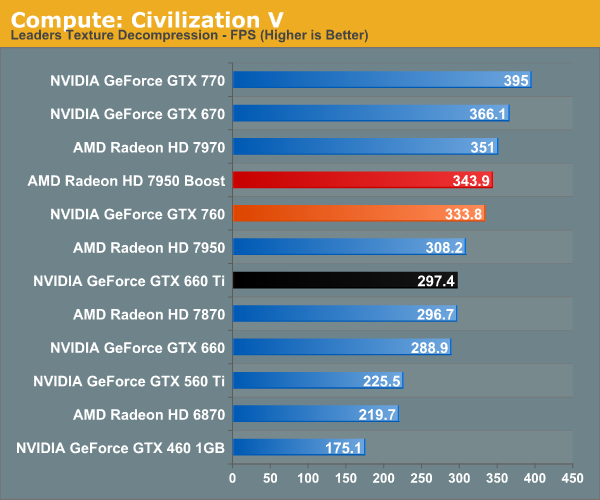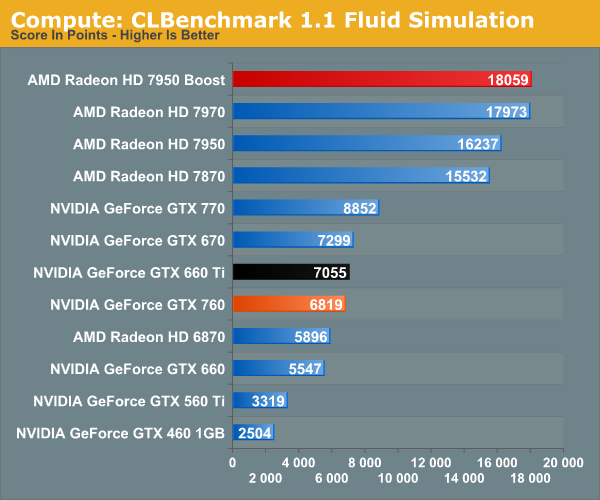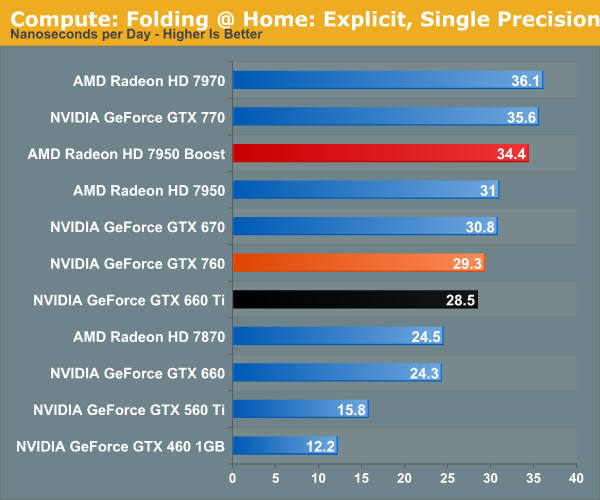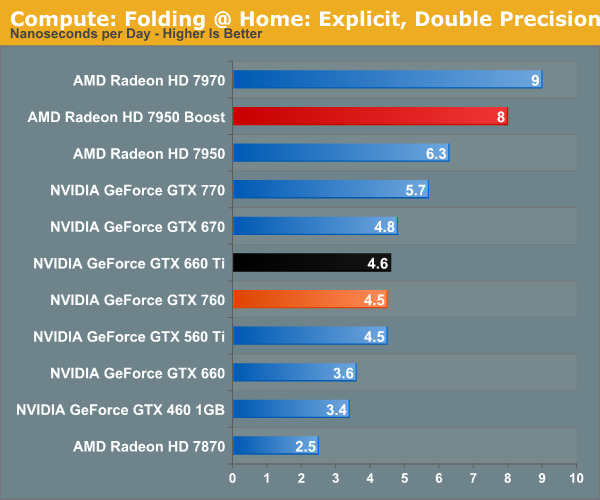NVIDIA GeForce GTX 760 Review: The New Enthusiast Kepler
by Ryan Smith on June 25, 2013 9:00 AM ESTCompute
Jumping into compute, we aren’t expecting too much here. Outside of DirectCompute GK104 is generally a poor compute GPU, and the loss of an SMX relative to the GTX 660 Ti isn’t doing the GTX 760 any favors here. By all appearances the GTX 760 is even more of a pure gaming card than the GTX 660 Ti was.
As always we'll start with our DirectCompute game example, Civilization V, which uses DirectCompute to decompress textures on the fly. Civ V includes a sub-benchmark that exclusively tests the speed of their texture decompression algorithm by repeatedly decompressing the textures required for one of the game’s leader scenes. While DirectCompute is used in many games, this is one of the only games with a benchmark that can isolate the use of DirectCompute and its resulting performance.

Civilization V once more validates that NVIDIA’s DirectCompute performance is generally up to snuff in this case. The fact that the GTX 760 is ahead of the GTX 660 Ti by any degree took us by surprise at first, but we’re likely looking at a scenario where the wider memory bus and/or larger L2 cache of GTX 760 offset some of the general compute gap.
Our next benchmark is LuxMark2.0, the official benchmark of SmallLuxGPU 2.0. SmallLuxGPU is an OpenCL accelerated ray tracer that is part of the larger LuxRender suite. Ray tracing has become a stronghold for GPUs in recent years as ray tracing maps well to GPU pipelines, allowing artists to render scenes much more quickly than with CPUs alone.

Luxmark is entirely about compute performance, and as a result this is an exceptionally poor showing for the GTX 760, with the GTX 660 Ti having no trouble besting it.
Our 3rd benchmark set comes from CLBenchmark 1.1. CLBenchmark contains a number of subtests; we’re focusing on the most practical of them, the computer vision test and the fluid simulation test. The former being a useful proxy for computer imaging tasks where systems are required to parse images and identify features (e.g. humans), while fluid simulations are common in professional graphics work and games alike.


Breaking down our CLBenchmark results, the computer vision test has frequently favored raw clockspeed over total shader throughput, which gives the GTX 760 an interesting advantage here. It’s capable of easily leaving the GTX 660 Ti in the dust and even edge out the GTX 670. Of course this is still less than 2/3rds the performance of even the slowest AMD GCN card, reflecting AMD’s superior computer performance.
The fluid simulation is especially brutal in that regard. Once again shifting back to an almost complete reliance on shader throughput, GTX 760 slightly trails GTX 660 Ti, never mind the nearly three-fold difference between it and the 7950B.
Moving on, our 4th compute benchmark is FAHBench, the official Folding @ Home benchmark. Folding @ Home is the popular Stanford-backed research and distributed computing initiative that has work distributed to millions of volunteer computers over the internet, each of which is responsible for a tiny slice of a protein folding simulation. FAHBench can test both single precision and double precision floating point performance, with single precision being the most useful metric for most consumer cards due to their low double precision performance. Each precision has two modes, explicit and implicit, the difference being whether water atoms are included in the simulation, which adds quite a bit of work and overhead. This is another OpenCL test, as Folding @ Home has moved exclusively to OpenCL this year with FAHCore 17.


Unlike some of our other compute benchmarks, the GTX 760 doesn’t fare too poorly here when it comes to single precision. However it’s still notably behind the 7950B in this case. And with double precision it’s no contest.
Wrapping things up, our final compute benchmark is an in-house project developed by our very own Dr. Ian Cutress. SystemCompute is our first C++ AMP benchmark, utilizing Microsoft’s simple C++ extensions to allow the easy use of GPU computing in C++ programs. SystemCompute in turn is a collection of benchmarks for several different fundamental compute algorithms, as described in this previous article, with the final score represented in points. DirectCompute is the compute backend for C++ AMP on Windows, so this forms our other DirectCompute test.

As another compute throughput bound benchmark, the GTX 760 is essentially tied with the GTX 660 Ti. This benchmark is somewhat memory bandwidth sensitive, which is why the GTX 760 doesn’t outright lose to the GTX 660 Ti here.










110 Comments
View All Comments
Impulses - Thursday, June 27, 2013 - link
Hmm, it took a while but it seems like I finally have a suitable upgrade path from my CF 6950x2 (unlocked)... I paid about $225 for each of those and I just haven't seen a card (or a pair of cards) that would be a substantial enough upgrade for under $500. SLI GTX 760 is more than I was hoping for, when the 770 came in at $400 I almost expected this to come in at $300+.Now, the question is, will I be bottlenecking myself under future games with 2GB GTX 760s in SLI for gaming at 5760x1200 or 3600x1920? My 6950s have held up well but I've been playing a lot of older games too... Should I be looking at a single GTX 780 instead or something?
mapesdhs - Monday, July 1, 2013 - link
As is so often the case, that depends on the games you're playing, and whether you're
using any mods, etc. Heavily modded Skyrim definitely needs more than 2GB even with
one high-res display. Heavy AA also needs more VRAM. Personally, if I was going for
multi-screen gaming, I'd want more than 2GB. Others have mentioned a 4GB 760, so
maybe that's an option? Or of course there are the various 3GB AMD cards, though I
wouldn't bother with CF until AMD's new drivers are out.
Some advantages of getting a single 780: better upgrade path in the future, less
power consumption, no SLI issues. The down side of course is the cost.
Ian.
hasseb64 - Thursday, June 27, 2013 - link
headline:"The new Enthusiast kepler"
Enthusiast?
Ever heard about "Main stream"?
I have nothing more to say!
tynopik - Thursday, June 27, 2013 - link
typo: 'less than idea for an action game' -> idealFar Cry 3 page
sdgvtree - Saturday, June 29, 2013 - link
nput this URL:==== [www.shun-happlymall.com] ====
you can find many cheap and fashion stuff
dineshramdin - Tuesday, July 2, 2013 - link
The most attractive feature is the 256 bit bus that would enable you a huge bandwidth and you can deal with any sort of resolutions if necessary. and for laptop accessories and many more, check this out- http://tinyurl.com/neqrzr9
Buddhaz Priest - Friday, July 12, 2013 - link
Wow. initially I kind of panned the GTX 770 because I didn't feel it was enough of a jump from the 670 for the price difference. Seemed like it wasn't a big hardware jump and that you were paying for the software goodies like GPU Boost 2.0, but after seeing the number difference between the 670 and 770 I gotta say I'm pleasantly surprised with how well the 770 performs.BadThad - Friday, June 13, 2014 - link
Let's see, no mention of the R270? You can find them for $150-175 (cheaper than the GTX) and they are virtually the same as far as performance.j18kuhn - Thursday, January 22, 2015 - link
I got one at best buy for my first pc for 210 and now I'm waiting on the rest of my parts from amazonArtas1984 - Sunday, August 16, 2015 - link
Seeing how the new GTX960 is just slightly ahead of GTX760, i guess buying the GTX760 was a smart choice. The gap between GTX970 and GTX960 is MASSIVE.